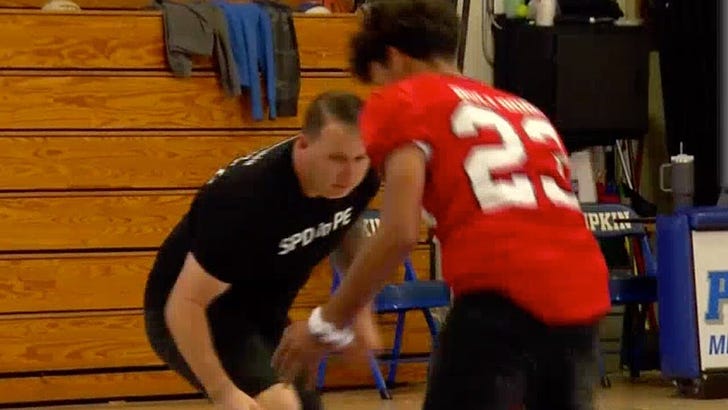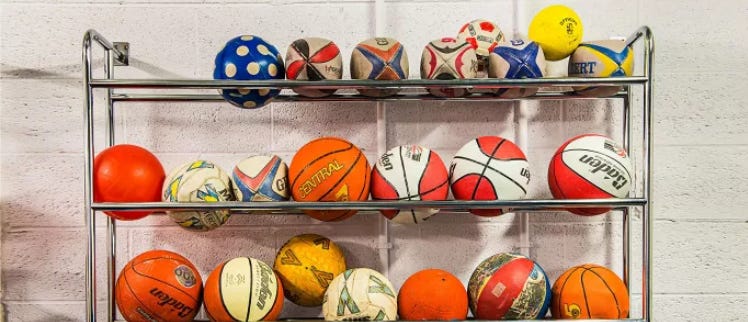Edition #226: What We Need To See More Of In Youth Sport & Physical Education
6 examples of positivity to spark better health.
The negativity around us can be overwhelming.
Sickness, conflict and economic hardship pushed at us more than ever.
I really enjoy Jon Gordon’s podcast and newsletter at Positive University. As coaches and parents, and with a vested interest in our own self-care, we need tools to snap us out of the negativity loop.
With that in mind, let’s focus on the positive and pull some feel good news connecting youth sport, physical education, leadership and positivity.
We need to see more: bridging the gap between law enforcement and our youth!
Springfield Police put on gym shorts and participate in middle school physical education classes.
Building relationships, breaking negative barriers.
This is example 1 of what we need to see more of:
We need to see more: growing the leadership!
Bethel College in Kansas (USA) announced expansion of its health and human performance curriculum. While the recent trend has been to decrease curriculum in preparing the next generation of physical activity leaders.
Queen's University "suspended" its phys-ed program a few years back, an example of a trend of universities to move away from such degrees.
The decline in physical education at the college/university level means less leaders for our communities.
The Bethel example is reversing this trend.
From this article announcing the expansion:
“The Health and Human Performance major will prepare students for a field in which the job market is growing,” said Robert Milliman, vice president for academic affairs.
“For example, according to the U.S. Bureau of Labor Statistics, from 2020-30, jobs in exercise science will grow 166%. In addition to the national growth of this profession, there is student demand at Bethel for all of the concentrations.
“With the Health and Human Performance major, more students will have excellent career choices in fields represented by Health and Fitness, Exercise Science and Health and Physical Education Teaching.
“Students in other majors, especially those in social work, teacher education and nursing, will also find courses taught in the exercise science and the health and fitness areas useful for their major.”
“We are excited about the launch of this new program,” said Heidi Hoskinson, vice president for enrollment management. “Prospective students are increasingly looking for these specialty areas of study, so being able to offer them as a major will make Bethel a very attractive college choice.”
We need to see more: More countries following Scotland’s lead in rising participation in Physical Education classes.
Scotland has seen a remarkable rise in participation in PE classes. In 2000 there were 3,028 higher entries - by 2022 that had almost quadrupled to 11,850.
“It’s keeping the ‘physical’ in physical education, but also keeping the ‘education’ in physical education - that we’re not just making [pupils] run about,” she says. “That they’re also able to understand what they’re doing and why they’re doing it - and having fun while they’re doing it.”
See the full story here:
https://www.tes.com/magazine/analysis/general/rise-pe-schools-scotland-physical-education
We need to see more: building relationships through sport, at any age.
While we use the term youth sport, sport participation benefits are not limited to youth under 16 or 18 years of age.
British Army physical trainers visit to build relationships through sport
At one point historically, cultural exchanges around sport were the norm. I remember as a young person annual hockey exchanges to other provinces and countries for a tournament where we would billet with a hosting family. Those days seem to have disappeared and been replaced by countless out of region tournaments with stays at faceless hotels.
In Virginia, this example reminded me of those great trips of yesteryear and should be brought back to increase the social and cultural connection through sport.
From the below article:
“Friend and ally troops from Europe stepped up their game and crossed over the pond to share the rock of expertise they have netted in training, sport and life.
Fort Gregg-Adams hosted the Royal Army Physical Training Corps basketball team Oct. 5-12. The trip included an official visit featuring a community outreach event with local youth and culminated in an Oct. 11 basketball game featuring RAPTC versus the Fort Gregg-Adams team.
The cultural and sport-focused visit also included an engagement with the William & Mary collegiate men’s basketball team, a Washington D.C. trip and a staff ride the command historian for Combined Arms Support Command, Karl Rubis.”
The full story here:
We need to see more: promoting the benefits of youth sport participation more often.
Exposure to physical and mental benefits are critical in bringing opportunities together.
Sometimes hearing them more often helps educate those in our culture not as convinced that this medicine is what our youth need, and how to deliver.
Dr. Shilagh Mirgain recently gave a great overview here:
We need to see more: tools for coaches in dealing with negative behaviors.
U.S. Center for Safe Sport recently released a new Bullying Prevention Handbook developed for youth sport coaches.
Changing times, negative behaviors require evolution and resources in tools to deal with them.
This step is a positive for sport organizations to not only increase awareness but tools to resolve an ongoing issue.




